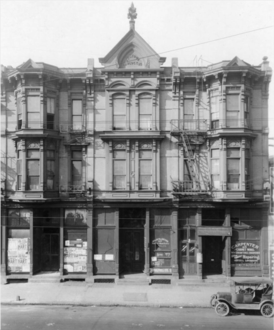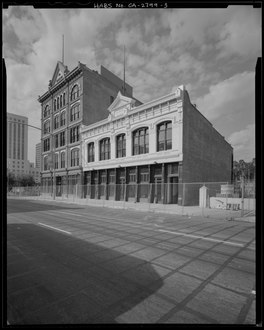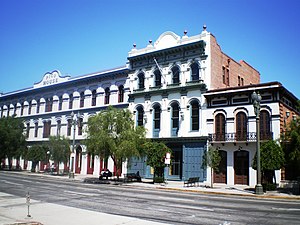Template:Buildings on Main Street in Los Angeles Plaza Historic District
Gallery (west side)[edit]
-
Sentous Block a.k.a Sentous Building, 1920
Gallery (east side)[edit]
-
Pico House in 1875
-
Pico House and the Plaza in 1876, photo taken from Fort Moore
-
Pico House today
-
Pico House, Merced Theater and Masonic Hall
Pico House[edit]
Pico House was a luxury hotel built in 1870 by Pío Pico, a successful businessman who was the last Mexican Governor of Alta California. With indoor plumbing, gas-lit chandeliers, a grand double staircase, lace curtains, and a French restaurant, the Italianate three-story, 33-room hotel was the most elegant hotel in Southern California. It had a total of nearly eighty rooms. The Pico House is listed as a California Historical Landmark (No. 159).
Masonic Hall[edit]
Masonic Hall at 416 N. Main St., was built in 1858 as Lodge 42 of the Free and Accepted Masons. The building was a painted brick structure with a symbolic "Masonic eye" below the parapet. In 1868, the Masons moved to larger quarters further south. Afterward, the building was used for many purposes, including a pawn shop and boarding house. It is the oldest building in Los Angeles south of the Plaza.
Merced Theater[edit]
The Merced Theater, completed in 1870, was built in an Italianate style and operated as a live theatre from 1871 to 1876. When the Woods Opera House opened nearby in 1876, the Merced ceased being the city's leading theatre.[1] Eventually, it gained an "unenviable reputation" because of "the disreputable dances staged there, and was finally closed by the authorities."[2]
Plaza House[edit]
This two-story building at 507–511 N. Main St. houses part of the LA Plaza de Cultura y Artes, which includes the Vickrey -Brunswig Building next door.[3] It is inscribed on its upper floor, and on 1890s maps it is marked, "Garnier Block" (not to be confused with the Garnier Block/Building on Los Angeles Street, one block away). Commissioned in 1883 by Philippe Garnier, once housed the "La Esperanza" bakery.[4]
Vickrey-Brunswig Building[edit]
This five-story brick building facing the Plaza at 501 N. Main St. houses LA Plaza de Cultura y Artes, which also occupies the Plaza House next door. It was built in 1888 and combines Italianate and Victorian architecture; the architect was Robert Brown Young.[5]
Site of Sentous Building[edit]
The Sentous Block or Sentous Building (19th c., demolished late 1950s) was located at 615-9 N Main St., with a back entrance on 616-620 North Spring St. (previously called Upper Main St., then San Fernando St.). Designed in 1886 by Burgess J. Reeve. Louis Sentous was a French pioneer in the early days of Los Angeles.[6] The San Fernando Theatre was located here. The site is now part of the El Pueblo parking lot.[7][8] <ref>
- ^ Lois Ann Woodward (1936). "Merced Theater" (PDF). State of California, Department of Natural Resources.
- ^ Rose L. Ellerbe (1925-10-25). "City's Progress Threatens Ancient Landmarks: Structures Once City's Pride Now Hidden in Squalor". Los Angeles Times.
- ^ "Plaza House", Library of Congress
- ^ "Plaza House", Water and Power Associates
- ^ "LA Plaza de Cultura y Artes, Vickrey-Brunswig Building", Los Angeles Conservancy
- ^ Louis Sentous biography, Bridge to the Pyrenees
- ^ "San Fernando Theatre", Los Angeles Theatres
- ^ plate 003 of the 1910 Baist Real Estate Survey








